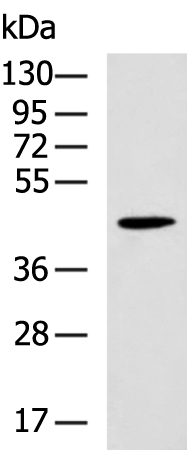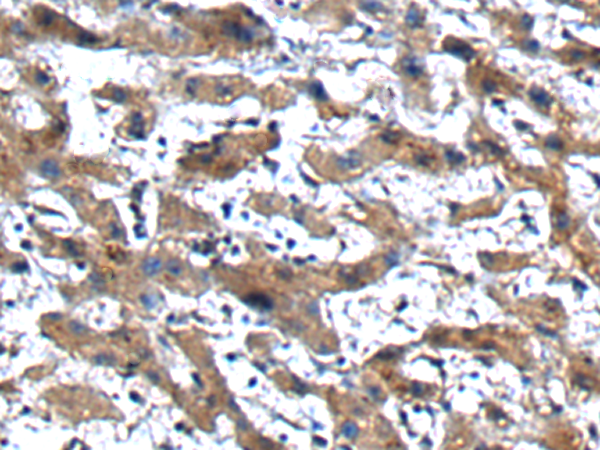

| WB | 咨询技术 | Human,Mouse,Rat |
| IF | 咨询技术 | Human,Mouse,Rat |
| IHC | 1/50-1/100 | Human,Mouse,Rat |
| ICC | 技术咨询 | Human,Mouse,Rat |
| FCM | 咨询技术 | Human,Mouse,Rat |
| Elisa | 1/5000-1/10000 | Human,Mouse,Rat |
| Aliases | SHFM6; STHAG8; WNT-12 |
| WB Predicted band size | 43 kDa |
| Host/Isotype | Rabbit IgG |
| Antibody Type | Primary antibody |
| Storage | Store at 4°C short term. Aliquot and store at -20°C long term. Avoid freeze/thaw cycles. |
| Species Reactivity | Human, Mouse |
| Immunogen | Synthetic peptide of human WNT10B |
| Formulation | Purified antibody in PBS with 0.05% sodium azide and 50% glycerol. |
+ +
以下是关于WNT10B抗体的3篇参考文献及其简要摘要:
1. **"WNT10B inhibits human adipogenesis by modulating canonical and non-canonical pathways"**
*Kang, S. et al. (2007)*
该研究利用WNT10B抗体检测其在脂肪细胞分化中的表达,发现WNT10B通过调控经典(β-catenin依赖)和非经典(如WNT/Ca²⁺)信号通路,抑制人类前脂肪细胞分化为成熟脂肪细胞。
2. **"The Wnt receptor Frizzled4 regulates stem cell potency and Wnt signaling in colon cancer"**
*Badders, N.M. et al. (2009)*
研究中通过WNT10B抗体分析结肠癌组织中WNT10B的定位及表达水平,发现其与癌症干细胞自我更新相关,并揭示WNT10B通过Frizzled受体调控肿瘤发生和转移的分子机制。
3. **"WNT10B enhances proliferation through β-catenin and predicts poor survival in breast cancer"**
*Liang, Y. et al. (2016)*
该文献使用WNT10B抗体进行免疫组化分析,发现WNT10B在乳腺癌中高表达,并通过激活β-catenin信号通路促进肿瘤细胞增殖,其过表达与患者预后不良显著相关。
4. **"Antibody-mediated inhibition of WNT10B signaling suppresses osteogenic differentiation in vitro"**
*Ho, H.Y.H. et al. (2012)*
研究通过WNT10B中和抗体阻断其功能,证明WNT10B在成骨细胞分化中的关键作用,抑制其信号会显著降低骨形成相关基因(如Runx2)的表达。
这些研究均直接使用WNT10B抗体进行蛋白检测或功能研究,涵盖脂肪代谢、癌症机制及骨发育等领域。
Wnt10b antibody is a research tool designed to detect and analyze the Wnt10b protein, a member of the Wnt family of signaling molecules. Wnt proteins are evolutionarily conserved glycoproteins critical for embryonic development, tissue homeostasis, and stem cell regulation. Wnt10b, specifically, plays a dual role in canonical (β-catenin-dependent) and non-canonical Wnt signaling pathways. It is implicated in adipogenesis inhibition, bone formation, and hair follicle development. Dysregulation of Wnt10b is linked to diseases such as obesity, osteoporosis, and cancers, including breast and colorectal cancer.
The antibody is widely used in immunohistochemistry, Western blotting, and flow cytometry to study Wnt10b expression patterns, localization, and interactions. Its applications extend to exploring molecular mechanisms in developmental biology, metabolic disorders, and tumorigenesis. For instance, elevated Wnt10b levels in certain cancers correlate with enhanced cell proliferation and metastasis, making it a potential therapeutic target. Conversely, reduced Wnt10b activity in adipose tissue may contribute to metabolic syndrome.
Commercial Wnt10b antibodies are typically raised in rabbits or mice against specific epitopes of the human or murine protein. Validation includes testing for cross-reactivity with other Wnt family members to ensure specificity. Despite its utility, challenges remain in standardizing detection across tissue types due to low endogenous protein levels and pathway complexity. Ongoing research aims to clarify its context-dependent roles and therapeutic potential in regenerative medicine and oncology.
×